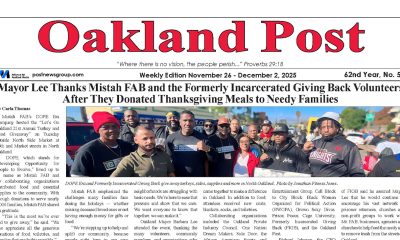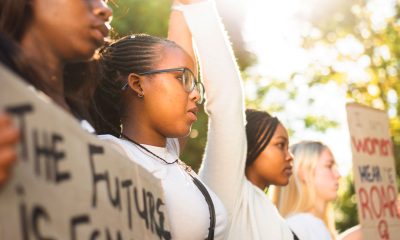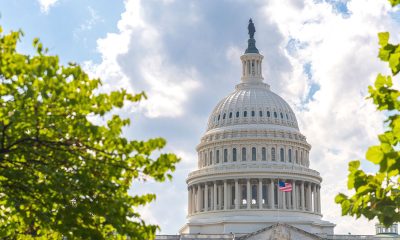Activism
Losing Income Chief Cause of Homelessness, UCSF Study Finds
Losing income is the No. 1 reason Californians end up homeless — and the vast majority of them say a subsidy of as little as $300 a month could have kept them off the streets. That’s according to a new study out of UC San Francisco that provides the most comprehensive look yet at California’s homeless crisis.

By Marisa Kendall
CalMatters
Losing income is the No. 1 reason Californians end up homeless — and the vast majority of them say a subsidy of as little as $300 a month could have kept them off the streets.
That’s according to a new study out of UC San Francisco that provides the most comprehensive look yet at California’s homeless crisis.
In the six months prior to becoming homeless, the Californians surveyed were making a median income of just $960 a month. The median rent for a two-bedroom apartment in California is nearly three times that, according to Zillow. And though survey participants listed a myriad of reasons why they lost their homes, more people cited a loss of, or reduction in, income than anything else.
The study’s authors say the findings highlight the idea that money, more than addiction, mental health, poor decisions or other factors, is the main cause of — and potential solution to — homelessness.
“I think it’s really important to note how desperately poor people are, and how much it is their poverty and the high housing costs that are leading to this crisis,” said Margot Kushel, a physician who directs the UCSF Benioff Homelessness and Housing Initiative, which conducted the study.
Already the study — which the authors say is the most representative homelessness survey conducted in the U.S. since the mid-1990s — has drawn attention from high places.
The initial idea for the survey came from California Health and Human Services Secretary Mark Ghaly, Kushel said. Ghaly’s office has been involved along the way, though the state didn’t fund the research.
“As we drive toward addressing the health and housing needs of Californian’s experiencing homelessness, this study reinforces the importance of comprehensive and integrated supports,” Ghaly said in a news release. “California is taking bold steps to address unmet needs for physical and behavioral health services, to create a range of housing options that are safe and stable, and to meet people where they are at. We are grateful for the voices of those who participated in this study, as they will help guide our approach.”
The survey comes as local governments press Gov. Gavin Newsom to distribute ongoing funding to fight homelessness, arguing the one-time grants he has doled out so far don’t allow them to make lasting progress. Newsom has resisted that kind of multi-year commitment, although his administration has allocated nearly $21 billion toward homelessness and housing since he took office.
The UCSF team surveyed 3,198 unhoused adults throughout California between October 2021 and November 2022, and conducted in-depth interviews with 365 of those participants.
What drives California’s homeless crisis?
When asked why they left their last home, respondents cited conflict between roommates, not wanting to impose on the person or people they were living with, domestic violence, illness and breakups.
A loss of or reduction in income was the most common response, with 12% of people saying that’s what caused their homelessness. Just 4% blamed their own substance use or drinking.
All of those varied factors that led people to lose their homes often have underlying roots in economic instability, said Jennifer Wolch, a professor emerita at UC Berkeley specializing in homelessness.
“This lack of income and severe instability and housing precarity, it has spillover effects on people’s relationships, their use of alcohol and other kinds of problematic substances,” she said. “It impinges on their health status.”
The story told by one survey participant, identified as Carlos, shows how someone can gradually descend into homelessness. He had to stop working after falling off a ladder and injuring his spine, but wasn’t eligible for workers’ compensation because he had been paid in cash. Unable to afford his rent, he moved out of his apartment and rented a room in a new place. He soon left due to conflicts with his roommates. He then briefly lived with his sister’s family, until they faced COVID-related job loss and he moved out to avoid becoming a burden. He lived in his truck until it was towed due to unpaid parking tickets. Now, he lives in an encampment in a park.
Most of the homeless Californians surveyed said a relatively small amount of cash would have saved them from the street. Seventy percent said a monthly rental subsidy of $300-$500 would have kept them from becoming homeless, while 82% believed a one-time payment of between $5,000 and $10,000 would have worked.
Jennifer Loving, CEO of Santa Clara County nonprofit Destination: Home, hopes the study’s findings will help debunk what she says is a common myth that people are homeless because of their individual failings, rather than because rents are outpacing wages. She’d like to see California’s leaders take notice.
“Hopefully it will inform a statewide strategy,” she said, “because we need a statewide strategy to be able to manage how we are addressing homelessness.”
Another California homeless myth
Another myth the study attempts to dispel is that most homeless people flock to California cities because of warm weather, liberal policies and generous services. In reality, 90% of the people surveyed said they were last housed in California, and 75% live in the same county as where they lost their housing.
That’s important to remember, Wolch said, because it’s easy to disregard unhoused people who we think “aren’t from here” and haven’t paid taxes here.
“People who are homeless are your neighbors,” she said. “People who are homeless live in the same city that you do and they possibly have lived there longer than you have.”
The survey painted a bleak picture of the traumas and tragedies that made survey participants more vulnerable to ending up on the street. People reported growing up in depressed communities with few job opportunities, where they experienced exploitation and discrimination. Nearly three-quarters said they had experienced physical violence during their lives, and one-quarter had experienced sexual violence.
One in three people surveyed attempted suicide at some point.
Mental health and addiction also were a common undercurrent in the lives of many of the unhoused people surveyed, which is to be expected in a population that has suffered so much trauma, according to the researchers. Two-thirds of people reported experiencing mental health symptoms — including depression, anxiety or hallucinations — in the past 30 days. Homelessness and all it entails, including lack of sleep, violence and difficulty accessing medication, exacerbated their symptoms, many people said.
About one-third of people reported using drugs three or more times a week — mostly methamphetamines. And 1 in 5 people who reported regular drug or heavy alcohol use said they wanted addiction treatment but couldn’t get it.
Jail to homelessness pipeline
The study also emphasizes the relationship between incarceration and homelessness, said Alex Visotzky, senior California Policy Fellow for the National Alliance to End Homelessness.
More than three-quarters of people surveyed had been incarcerated at some point during their life. And in the six months before becoming homeless, 43% were in jail or prison, or were on probation or parole. The vast majority of those who had been incarcerated received no help signing up for housing, healthcare or benefits upon release.
“That drove home for me this point: Incarceration, homelessness and then subsequent criminalization are fueling a really vicious cycle for marginalized people, especially Black and Latino Californians, that’s both causing and prolonging homelessness,” Visotzky said.
‘We don’t have enough housing for poor folks’
To solve the homelessness crisis, the main problem California needs to address is the lack of housing that’s affordable for extremely low-income residents, according to the researchers. The state has just 24 affordable and available homes for every 100 extremely low-income households, according to the National Low Income Housing Coalition.
Among the solutions the researchers proposed: expanding vouchers that use federal, state and local dollars to subsidize people’s rent. They also suggested piloting shared housing programs where multiple households live together and split costs, while also providing funds to help people remain with or move in with family or friends.
Kushel hopes the study helps drive public support for these ideas, which in turn will spur politicians to act.
“I hope that it really focuses our efforts on housing, which is the only way out of homelessness,” Kushel said. “It’s almost so obvious it’s hard to speak about. We don’t have enough housing for poor folks.”
The study is available at https://homelessness.ucsf.edu/our-impact/our-studies/california-statewide-study-people-experiencing-homelessness.
Copyright © 2023 Bay City News, Inc. All rights reserved. Republication, rebroadcast or redistribution without the express written consent of Bay City News, Inc. is prohibited. Bay City News is a 24/7 news service covering the greater Bay Area.
Activism
Lu Lu’s House is Not Just Toying Around with the Community
Wilson and Lambert will be partnering with Mayor Barbara Lee on a toy giveaway on Dec. 20. Young people, like Dremont Wilkes, age 15, will help give away toys and encourage young people to stay in school and out of trouble. Wilkes wants to go to college and become a specialist in financial aid. Sports agent Aaron Goodwin has committed to giving all eight young people from Lu Lu’s House a fully paid free ride to college, provided they keep a 3.0 grade point average and continue the program. Lu Lu’s House is not toying around.

Special to the Post
Lu Lu’s House is a 501c3 organization based in Oakland, founded by Mr. Zirl Wilson and Mr. Tracy Lambert, both previously incarcerated. After their release from jail, they wanted to change things for the better in the community — and wow, have they done that!
The duo developed housing for previously incarcerated people, calling it “Lu Lu’s House,” after Wilson’s wonderful wife. At a time when many young people were robbing, looting, and involved in shootings, Wilson and Lambert took it upon themselves to risk their lives to engage young gang members and teach them about nonviolence, safety, cleanliness, business, education, and the importance of health and longevity.
Lambert sold hats and T-shirts at the Eastmont Mall and was visited by his friend Wilson. At the mall, they witnessed gangs of young people running into the stores, stealing whatever they could get their hands on and then rushing out. Wilson tried to stop them after numerous robberies and finally called the police, who Wilson said, “did not respond.” Having been incarcerated previously, they realized that if the young people were allowed to continue to rob the stores, they could receive multiple criminal counts, which would take their case from misdemeanors to felonies, resulting in incarceration.

Lu Lu’s House traveled to Los Angeles and obtained more than 500 toys
for a Dec. 20 giveaway in partnership with Oakland Mayor Barbara
Lee. Courtesy Oakland Private Industry,
Wilson took it upon himself to follow the young people home and when he arrived at their subsidized homes, he realized the importance of trying to save the young people from violence, drug addiction, lack of self-worth, and incarceration — as well as their families from losing subsidized housing. Lambert and Wilson explained to the young men and women, ages 13-17, that there were positive options which might allow them to make money legally and stay out of jail. Wilson and Lambert decided to teach them how to wash cars and they opened a car wash in East Oakland. Oakland’s Initiative, “Keep the town clean,” involved the young people from Lu Lu’s House participating in more than eight cleanup sessions throughout Oakland. To assist with their infrastructure, Lu Lu’s House has partnered with Oakland’s Private Industry Council.
For the Christmas season, Lu Lu’s House and reformed young people (who were previously robbed) will continue to give back.
Lu Lu’s House traveled to Los Angeles and obtained more than 500 toys.
Wilson and Lambert will be partnering with Mayor Barbara Lee on a toy giveaway on Dec. 20. Young people, like Dremont Wilkes, age 15, will help give away toys and encourage young people to stay in school and out of trouble. Wilkes wants to go to college and become a specialist in financial aid. Sports agent Aaron Goodwin has committed to giving all eight young people from Lu Lu’s House a fully paid free ride to college, provided they keep a 3.0 grade point average and continue the program. Lu Lu’s House is not toying around.
Activism
Desmond Gumbs — Visionary Founder, Mentor, and Builder of Opportunity
Gumbs’ coaching and leadership journey spans from Bishop O’Dowd High School, Oakland High School, Stellar Prep High School. Over the decades, hundreds of his students have gone on to college, earning academic and athletic scholarships and developing life skills that extend well beyond sports.

Special to the Post
For more than 25 years, Desmond Gumbs has been a cornerstone of Bay Area education and athletics — not simply as a coach, but as a mentor, founder, and architect of opportunity. While recent media narratives have focused narrowly on challenges, they fail to capture the far more important truth: Gumbs’ life’s work has been dedicated to building pathways to college, character, and long-term success for hundreds of young people.
A Career Defined by Impact
Gumbs’ coaching and leadership journey spans from Bishop O’Dowd High School, Oakland High School, Stellar Prep High School. Over the decades, hundreds of his students have gone on to college, earning academic and athletic scholarships and developing life skills that extend well beyond sports.
One of his most enduring contributions is his role as founder of Stellar Prep High School, a non-traditional, mission-driven institution created to serve students who needed additional structure, belief, and opportunity. Through Stellar Prep numerous students have advanced to college — many with scholarships — demonstrating Gumbs’ deep commitment to education as the foundation for athletic and personal success.

NCAA football history was made this year when Head Coach from
Mississippi Valley State, Terrell Buckley and Head Coach Desmond
Gumbs both had starting kickers that were women. This picture was
taken after the game.
A Personal Testament to the Mission: Addison Gumbs
Perhaps no example better reflects Desmond Gumbs’ philosophy than the journey of his son, Addison Gumbs. Addison became an Army All-American, one of the highest honors in high school football — and notably, the last Army All-Americans produced by the Bay Area, alongside Najee Harris.
Both young men went on to compete at the highest levels of college football — Addison Gumbs at the University of Oklahoma, and Najee Harris at the University of Alabama — representing the Bay Area on a national level.
Building Lincoln University Athletics From the Ground Up
In 2021, Gumbs accepted one of the most difficult challenges in college athletics: launching an entire athletics department at Lincoln University in Oakland from scratch. With no established infrastructure, limited facilities, and eventually the loss of key financial aid resources, he nonetheless built opportunities where none existed.
Under his leadership, Lincoln University introduced:
- Football
- Men’s and Women’s Basketball
- Men’s and Women’s Soccer
Operating as an independent program with no capital and no conference safety net, Gumbs was forced to innovate — finding ways to sustain teams, schedule competition, and keep student-athletes enrolled and progressing toward degrees. The work was never about comfort; it was about access.
Voices That Reflect His Impact
Desmond Gumbs’ philosophy has been consistently reflected in his own published words:
- “if you have an idea, you’re 75% there the remaining 25% is actually doing it.”
- “This generation doesn’t respect the title — they respect the person.”
- “Greatness is a habit, not a moment.”
Former players and community members have echoed similar sentiments in public commentary, crediting Gumbs with teaching them leadership, accountability, confidence, and belief in themselves — lessons that outlast any single season.
Context Matters More Than Headlines
Recent articles critical of Lincoln University athletics focus on logistical and financial hardships while ignoring the reality of building a new program with limited resources in one of the most expensive regions in the country. Such narratives are ultimately harmful and incomplete, failing to recognize the courage it takes to create opportunity instead of walking away when conditions are difficult.
The real story is not about early struggles — it is about vision, resilience, and service.
A Legacy That Endures
From founding Stellar PREP High School, to sending hundreds of students to college, to producing elite athletes like Addison Gumbs, to launching Lincoln University athletics, Desmond Gumbs’ legacy is one of belief in young people and relentless commitment to opportunity.
His work cannot be reduced to headlines or records. It lives on in degrees earned, scholarships secured, leaders developed, and futures changed — across the Bay Area and beyond.
Activism
Families Across the U.S. Are Facing an ‘Affordability Crisis,’ Says United Way Bay Area
United Way’s Real Cost Measure data reveals that 27% of Bay Area households – more than 1 in 4 families – cannot afford essentials such as food, housing, childcare, transportation, and healthcare. A family of four needs $136,872 annually to cover these basic necessities, while two adults working full time at minimum wage earn only $69,326.

By Post Staff
A national poll released this week by Marist shows that 61% of Americans say the economy is not working well for them, while 70% report that their local area is not affordable. This marks the highest share of respondents expressing concern since the question was first asked in 2011.
According to United Way Bay Area (UWBA), the data underscores a growing reality in the region: more than 600,000 Bay Area households are working hard yet still cannot afford their basic needs.
Nationally, the Marist Poll found that rising prices are the top economic concern for 45% of Americans, followed by housing costs at 18%. In the Bay Area, however, that equation is reversed. Housing costs are the dominant driver of the affordability crisis.
United Way’s Real Cost Measure data reveals that 27% of Bay Area households – more than 1 in 4 families – cannot afford essentials such as food, housing, childcare, transportation, and healthcare. A family of four needs $136,872 annually to cover these basic necessities, while two adults working full time at minimum wage earn only $69,326.
“The national numbers confirm what we’re seeing every day through our 211 helpline and in communities across the region,” said Keisha Browder, CEO of United Way Bay Area. “People are working hard, but their paychecks simply aren’t keeping pace with the cost of living. This isn’t about individual failure; it’s about policy choices that leave too many of our neighbors one missed paycheck away from crisis.”
The Bay Area’s affordability crisis is particularly defined by extreme housing costs:
- Housing remains the No. 1 reason residents call UWBA’s 211 helpline, accounting for 49% of calls this year.
- Nearly 4 in 10 Bay Area households (35%) spend at least 30% of their income on housing, a level widely considered financially dangerous.
- Forty percent of households with children under age 6 fall below the Real Cost Measure.
- The impact is disproportionate: 49% of Latino households and 41% of Black households struggle to meet basic needs, compared to 15% of white households.
At the national level, the issue of affordability has also become a political flashpoint. In late 2025, President Donald Trump has increasingly referred to “affordability” as a “Democrat hoax” or “con job.” While he previously described himself as the “affordability president,” his recent messaging frames the term as a political tactic used by Democrats to assign blame for high prices.
The president has defended his administration by pointing to predecessors and asserting that prices are declining. However, many Americans remain unconvinced. The Marist Poll shows that 57% of respondents disapprove of Trump’s handling of the economy, while just 36% approve – his lowest approval rating on the issue across both terms in office.
-

 #NNPA BlackPress3 weeks ago
#NNPA BlackPress3 weeks agoLIHEAP Funds Released After Weeks of Delay as States and the District Rush to Protect Households from the Cold
-

 Alameda County3 weeks ago
Alameda County3 weeks agoSeth Curry Makes Impressive Debut with the Golden State Warriors
-

 Activism4 weeks ago
Activism4 weeks agoOakland Post: Week of November 26 – December 2, 2025
-

 #NNPA BlackPress3 weeks ago
#NNPA BlackPress3 weeks agoSeven Steps to Help Your Child Build Meaningful Connections
-

 #NNPA BlackPress3 weeks ago
#NNPA BlackPress3 weeks agoSeven Steps to Help Your Child Build Meaningful Connections
-

 #NNPA BlackPress3 weeks ago
#NNPA BlackPress3 weeks agoTrinidad and Tobago – Prime Minister Confirms U.S. Marines Working on Tobago Radar System
-

 #NNPA BlackPress3 weeks ago
#NNPA BlackPress3 weeks agoThanksgiving Celebrated Across the Tri-State
-

 #NNPA BlackPress3 weeks ago
#NNPA BlackPress3 weeks agoTeens Reject Today’s News as Trump Intensifies His Assault on the Press























































